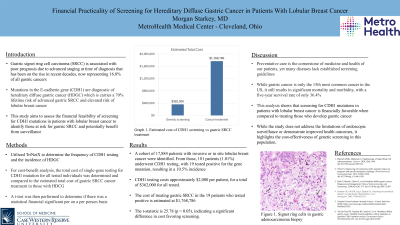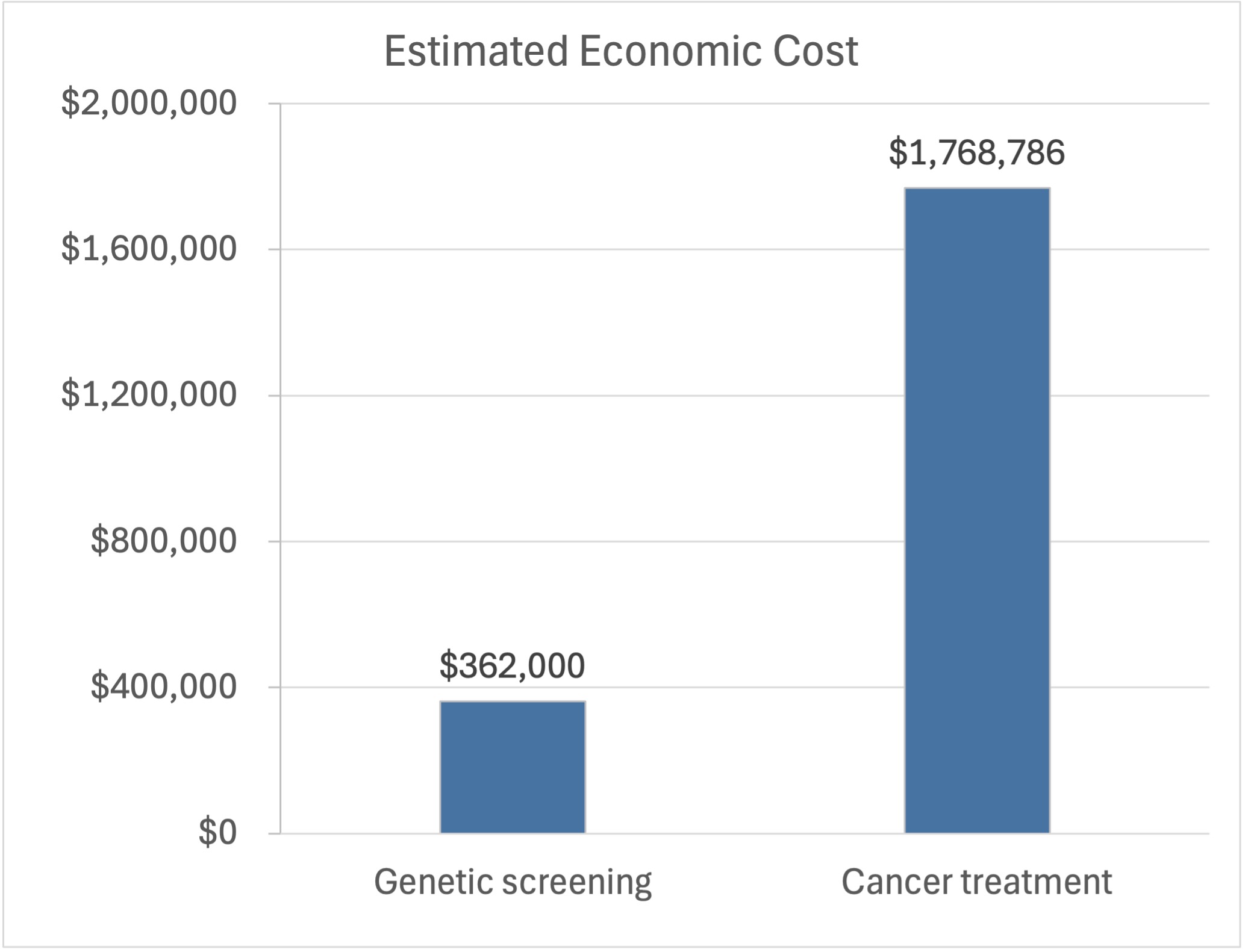Tuesday Poster Session
Category: Stomach
P5064 - Financial Practicality of Screening for Hereditary Diffuse Gastric Cancer in Patients With Lobular Breast Cancer
Tuesday, October 29, 2024
10:30 AM - 4:00 PM ET
Location: Exhibit Hall E

Has Audio

Morgan R. Starkey, MD
MetroHealth Medical Center
Cleveland, OH
Presenting Author(s)
Morgan R. Starkey, MD
MetroHealth Medical Center, Cleveland, OH
Introduction: Gastric signet ring cell carcinoma (SRCC) has been on the rise in recent decades, now representing 16.8% of all gastric cancers. Importantly, mutations in the E-cadherin gene (CDH1) are diagnostic of hereditary diffuse gastric cancer (HDGC) which carries a 70% lifetime risk of advanced gastric SRCC and elevated risk of lobular breast cancer (LBC). As there is no standard for gastric cancer screenings in the United States, this analysis aims to assess the financial feasibility of screening for CDH1 mutations in those with LBC to identify those at risk of developing gastric SRCC and would benefit from surveillance.
Methods: To address the financial practicality of screening for CDH1 mutations in individuals with LBC to identify those at risk of developing gastric SRCC, TriNetX was utilized to determine the current frequency of testing and incidence of HDGC. For cost-benefit analysis, the total cost of single-gene testing for CDH1 mutation for all tested individuals was compared to the estimated total cost of gastric SRCC cancer treatment in those with HDCG. A t-test was then performed to determine if there was a statistical financial significance on a per-person basis.
Results: A cohort of 17,884 were identified with a diagnosis of invasive or in situ LBC. CDH1 gene testing was completed for 181 patients, only 1.01% tested. Of those, 19 tested positive for a CDH1 gene variant, diagnosing them with HDGC. The estimated cost of single gene CDH1 mutation testing for 181 people was determined to be $362,000. In comparison, the estimated economic cost of treating advanced gastric SRCC in the 19 that tested positive is $1,768,786. The t-statistic in comparing these costs is 25.78 (p < 0.05), a highly significant difference in cost on a per-person basis.
Discussion: Preventative care is a cornerstone of medicine, yet many diseases lack screening guidelines. While gastric cancer is less common in the US, it still results in significant mortality, with a five-year survival rate of 36.4%. To help mitigate that, this analysis compared the cost difference between genetic screening of individuals with LBC for HDCG to identify those at high risk to treating those with HDCG that develop gastric cancer. The analysis revealed a significant cost difference favoring screening. Although this study only examines a specific population and does not address the limitations of surveillance or demonstrate improved outcomes, it does highlight that financial cost should not be considered a limiting factor.

Disclosures:
Morgan R. Starkey, MD. P5064 - Financial Practicality of Screening for Hereditary Diffuse Gastric Cancer in Patients With Lobular Breast Cancer, ACG 2024 Annual Scientific Meeting Abstracts. Philadelphia, PA: American College of Gastroenterology.
MetroHealth Medical Center, Cleveland, OH
Introduction: Gastric signet ring cell carcinoma (SRCC) has been on the rise in recent decades, now representing 16.8% of all gastric cancers. Importantly, mutations in the E-cadherin gene (CDH1) are diagnostic of hereditary diffuse gastric cancer (HDGC) which carries a 70% lifetime risk of advanced gastric SRCC and elevated risk of lobular breast cancer (LBC). As there is no standard for gastric cancer screenings in the United States, this analysis aims to assess the financial feasibility of screening for CDH1 mutations in those with LBC to identify those at risk of developing gastric SRCC and would benefit from surveillance.
Methods: To address the financial practicality of screening for CDH1 mutations in individuals with LBC to identify those at risk of developing gastric SRCC, TriNetX was utilized to determine the current frequency of testing and incidence of HDGC. For cost-benefit analysis, the total cost of single-gene testing for CDH1 mutation for all tested individuals was compared to the estimated total cost of gastric SRCC cancer treatment in those with HDCG. A t-test was then performed to determine if there was a statistical financial significance on a per-person basis.
Results: A cohort of 17,884 were identified with a diagnosis of invasive or in situ LBC. CDH1 gene testing was completed for 181 patients, only 1.01% tested. Of those, 19 tested positive for a CDH1 gene variant, diagnosing them with HDGC. The estimated cost of single gene CDH1 mutation testing for 181 people was determined to be $362,000. In comparison, the estimated economic cost of treating advanced gastric SRCC in the 19 that tested positive is $1,768,786. The t-statistic in comparing these costs is 25.78 (p < 0.05), a highly significant difference in cost on a per-person basis.
Discussion: Preventative care is a cornerstone of medicine, yet many diseases lack screening guidelines. While gastric cancer is less common in the US, it still results in significant mortality, with a five-year survival rate of 36.4%. To help mitigate that, this analysis compared the cost difference between genetic screening of individuals with LBC for HDCG to identify those at high risk to treating those with HDCG that develop gastric cancer. The analysis revealed a significant cost difference favoring screening. Although this study only examines a specific population and does not address the limitations of surveillance or demonstrate improved outcomes, it does highlight that financial cost should not be considered a limiting factor.

Figure: Estimated Economic Cost
Disclosures:
Morgan Starkey indicated no relevant financial relationships.
Morgan R. Starkey, MD. P5064 - Financial Practicality of Screening for Hereditary Diffuse Gastric Cancer in Patients With Lobular Breast Cancer, ACG 2024 Annual Scientific Meeting Abstracts. Philadelphia, PA: American College of Gastroenterology.
